Science Chapter 12 - Electricity
IMPORTANT NOTES
- There are two kinds of electric charges i.e., positive
and negative. The opposite charges attract each other and the similar charges
repel each other. Coulomb (C) is the standard unit of charge.
- Conductors: The substances through
which electricity can flow are called conductors. Silver, copper, gold and
aluminium are examples of conductors.
- Insulators: The substances through
which electricity cannot flow are called insulators. Glass, wood, porcelain and
rubber are examples of insulators.
- One coulomb: A body is said to have
one coulomb charge if it has 6.25 × 1018 electrons on it or is
deficit as compared to the normal number of electrons.
- Electric current: The rate of flow
of charge from a body at higher potential to a body at lower potential is called
electric current. Ampere (A) is the standard unit of current.
- Electric potential: The amount of
work done in moving a unit positive charge from infinity to a given point in an
electric field is called the electric potential at that point. Thus, electric
potential is a condition which determines the direction of flow of charges. The
unit of electric potential is volt (V).
- Potential difference: The amount of
work done in moving a unit positive charge from one point to another in an
electric field is called potential difference.
- Closed electric circuit: An electric
circuit in which all the components of the circuit are joined to one another,
such that continuous current flows through them, is called closed electric
circuit.
- Open electric circuit: An electric
circuit in which electric contact is broken at some point (say by a switch),
such that no current flows through the components of the circuit is called an
open circuit.
- Electric resistance: The opposition
or obstruction offered by a conductor to the flow of the electrons is called
electric resistance. In SI system unit of resistance is ohm (Ω).
- Resistivity: It is the amount of
resistance offered by a conductor of unit length and unit area of cross-section,
such that current enters and leaves from its opposite faces is called its
resistivity or specific resistance.
- Series circuit of resistors: When a
number of resistors are connected end to end such that tail end of one resistor
is connected to the initial end of the other resistor so as to form a closed
circuit, then such a circuit is called the series circuit.
- Parallel circuit of resistors: When
a number of resistors are connected in such a way that they have common positive
terminal and a common negative terminal, then the resistors are said to be
connected in parallel circuit.
- Ohm’s law: All physical conditions
of a conductor remaining the same, the current flowing through it is directly
proportional to the potential difference at its ends. If I is the current
flowing through a conductor, such that V is the potential difference at its
ends, then

Where R is the constant of proportionality and commonly called the
resistance of a conductor.
- Electric work: Electric work is said
to be done when a charge flows through a conductor at some potential difference.
If W is the amount of work done in carrying Q charge from one point to
another in an electric field, such that, V is the potential difference, then

- Electric power: The rate of doing
electric work is called the electric power. The SI unit of power is watt (W).
If W is the amount of electric work done in time t, such that P
is the power, then
- P =W/T
- But, W = I2Rt
- Thus, P = = I2R.
- Overloading: Overloading of circuit
means, passing more current through the circuit than it can tolerate without
damage.
- Short circuit: It means that live
and neutral wires come in contact with each other, thereby bypassing the
electrical device. It is caused due to melting of insulation of connecting wires
or the live wire getting connected to earth.
- Fuse: It is a safety device in an
electric circuit. It is the weakest point in an electric circuit, which melts
and breaks the electric circuit, when the circuit gets overloaded.
VERY SHORT ANSWER QUESTIONS
IMPORTANT QUESTIONS
1. Define electric work.
2. What is the unit of electric work? Define it, in
relation to quantity of charge and potential difference.
3. Name two bigger units of electric work.
4. What do you understand by the term current
electricity?
5. Define the term “electric current”.
6. How is an ammeter connected in an electric circuit
so as to measure electric current?
7. What is the unit of electric charge? How much
electric charge is on one electron?
8. If 12 J of work is done in moving 2 coulomb of
electric charge through a conductor, what is the potential difference at the
ends of the conductor?
9. State and define the SI unit of potential
difference.
10. State SI unit of electric power.
11. Define the SI unit of electric power.
12. Name and define the smallest commercial unit of
electricity.
13. Define kWh.
14. Prove: 1 kWh = 3.6 MJ.
15. Name two common materials used as heating
elements.
16. Name a metal which is used as filament in an
electric bulb.
17. What do you understand by the term fuse in an
electric circuit?
18. State the composition of material of the fuse
wire.
19. Where is a fuse placed in an electric circuit?
20. A bulb in an electric circuit is glowing. Is it a
close or open electric circuit?
21. What do you understand by the term electric
resistance?
22. How does electric resistance change with the
change in the length of conductor?
23. How does electric resistance change with the
change in the area of cross-section of conductor?
24. How does electric resistance of solid ionic
compounds compare with respect to molten compounds?
25. Why does a conducting wire offer resistance to the
flow of electrons?
26. What do you understand by the term electric
potential?
27. What do you understand by the term potential
difference?
QUESTIONS FROM CBSE EXAMINATION PAPERS
1. Two resistors of 20 Ω and 40 Ω are connected in
parallel in an electric circuit. How does the current passing through the two
resistors compare?
2. Two resistors of 30 Ω and 60 Ω are connected in
parallel in an electric circuit. How does the current passing through the two
resistors compare?
3. Define electric circuit. Distinguish between open
and closed circuit.
4. What is the lowest resistance that can be obtained
by combining four coils of resistors of 4 Ω, 8 Ω, 12 Ω and 24 Ω?
5. Write a mathematical expression for Joule’s law of
heating. Name one device which works on this principle.
6. What happens to the resistance of a conductor when
the length of the conductor is reduced to half?
7. Define the SI unit of resistance.
8. What happens to resistance of a conductor when
temperature is increased?
9. What is electrical resistivity? In a series
electrical circuit comprising a resistor made up of a metallic wire, the ammeter
reads 5 A. The reading of the ammeter decreases to half when the length of the
wire is doubled. Why?
10. What is the minimum resistance which can be made
using five resistors each of 1/5 Ω?
11. You have two metallic wires of resistances 6 ohm
and 3 ohm. How will you connect these wires to get the effective resistance of 2
ohm?
12. Draw a schematic diagram of a circuit consisting
of a cell of 1.5 V, 10 Ω resistor and15 Ω resistor and a plug key, all
connected in series.
13. Name the instrument used to measure electric
current in a circuit.
14. The voltage-current (V-I) graph of a metallic
circuit at two different temperatures T1 and T2 is shown, which of the two
temperatures is higher and why?

15. What is meant by saying that the potential
difference between two points is 1V?
16. A wire of resistivity ‘r’ is pulled to double its
length. What will be its new resistivity?
17. Name the physical quantity whose unit is Volt/
ampere.
18. Why do we use copper and aluminium wire for
transmission of electric current?
19. What is commercial unit of energy?
20. Name the instrument used for measuring:
(i) Potential difference (ii)
current
21. Define Ohm’s Law.
22. How is a Voltmeter connected in the circuit to
measure the potential difference between two points?
23. How is an ammeter connected in the circuit to
measure current flowing through a conductor?
24. Nichrome is used to make the elements of electric
heater. Why?
25. Calculate the energy consumed by 1200 W toaster in
200 minutes.
26. A lamp rated 100 W and 220 V is connected to mains
electric supply. What current is drawn from the supply line, if the voltage is
220 V?
27. Out of 60 W and 40 W lamps, which one has higher
resistance when we use?
28. If the distance between two electric charges is
doubled, how much will the force exerting between them change to?
29. Should the heating element of an electric iron be
made of iron, silver or nichrome wire?
30. Define the term ‘resistivity’ of a material.
31. Calculate the resistance of a conductor, if the
current flowing through it is 0.2 A when the applied potential difference is 0.8
volt.
SHORT ANSWER QUESTIONS
IMPORTANT QUESTIONS
1. Name two devices which can produce continuous
current. Which form of energy is responsible for the generation of electric
current in the devices named by you?
2. The resistance of a wire of length 80 cm and of
uniform area of cross-section 0.025 cm2, is found to be 1.50 ohm. Calculate
specific resistance of wire in SI units.
3. What should be the length of nichrome wire of
resistance 4.5 Ω, if the length of similar wire is 60 cm and resistance 2.5 Ω?
4. A charge of 5000 C flows through an electric
circuit in 2.5 hours. Calculate the magnitude of current flowing through the
circuit.
5. A battery can supply a charge of 2.5 × 103C.
If the current drawn from the battery is 12.5 A, calculate the time in which
battery will get discharged.
6. What is the resistance of (hot) electric arc lamp
when it uses a current of 25 A, while working at 440 V?
7. A current of 0.2 A flows through a conductor of
resistance 4.5 Ω. Calculate the p.d. at the ends of the conductor.
8. A bulb of resistance 400 Ù connected to 200 V mains
supply. Calculate the magnitude of the current flowing through the bulb.
9. Amongst the units given below, which units are of
(i) electric energy (ii) electric power?
(a) Watt hour (b) watt (c) kilowatt (d) kilowatt hour
10. (i) Distinguish between kilowatt and kilowatt
hour. (ii) How many kilowatts are equal to one horse power?
11. Name two materials which are commonly used for
making heating appliances and give their composition.
12. Answer the following questions regarding an
electric heater:
(i) Why is the heating coil placed in a circular
porcelain plate?
(ii) Why does heating coil not produce any visible
light?
13. Calculate the energy consumed by a heater, which
draws a current of 5 A at 200 V for 1 minute.
14. An electric press consumes 120 kJ of energy in 5
minutes, when the magnitude of current flowing through it is 2A. Calculate the
electric potential at which press operates.
15. A soldering rod draws energy of 45 kJ in 4 minutes
when current flowing through it is 6 A. Calculate the resistance of
heating element.
16. An electric device draws energy of 500 kJ in 1
minute. If the resistance of heating device is 20 Ω, calculate the current
flowing through the device.
17. Calculate the electric energy flowing into the
filament of an electric bulb in 20 s, when its resistance is 40 Ω and potential
difference across its terminals is 12 V.
18. An electric heater draws a current of 3.5 A at a
p.d. of 250 V. Calculate the power consumed by 4 such heaters.
19. An electric heater of power 1600 W has a
resistance of 36 Ω. Calculate the magnitude of current and p.d. at its ends.
20. (a) What is the potential of Earth?
(b) By drawing a diagram, show the movement of
electrons when a positively charged is connected to Earth.
21. A charge of 50 C is moved from infinity to two
points A and B in an electric field. The work done to do so up to A and B is 20
J and 25 J respectively. What is the potential difference between points A and
B?
22. How is electric potential generated in a conductor
during the flow of charges?
23. Chemical cells or dynamos do not produce
electrons. How do they produce current electricity?
QUESTIONS FROM CBSE EXAMINATION PAPERS
1. In an experiment to study the relation between the
potential difference across a resistor and the current through it, a student
recorded the following observations:

On examining the above observations, the teacher asked the student to
reject one set of readings as the values were out of agreement with the rest.
Which one of the above sets of readings can be rejected? Calculate the mean
value of resistance of the resistor based on the remaining four sets of
readings.
2. In an experiment to study the relation between the
potential difference across a resistor and the current through it, a student
recorded the following observations.

On examining the above observations, the teacher asked the student to
reject one set of readings as the values were out of agreement with the rest.
Which one of the above sets of readings can be rejected? Calculate the mean
value of resistance of the resistor based on the remaining four sets of
readings.
3. Define resistivity and state its S.I. unit. Does it
vary with temperature?
4. A wire is 1.0 m long; 0.2 mm diameter has
resistance of 20 Ω. Calculate the resistivity of material.
5. State the factors on which the resistance of a
cylindrical conductor depends. How will resistance of a conductor change if it
is stretched so that its length is doubled?
6. In an experiment to study the relationship between
the potential difference across a resistor and the current through it, a student
recorded the following observations:

Find in which one of the above sets of readings the trend is different
from others and must be rejected. Calculate the mean value of resistance of the
resistor based on the remaining sets of readings.
7. State Ohm’s law. “The resistance of a conductor is
1Ω.” What is meant by this statement?
8. Two electric bulbs A and B are marked 220 V, 40 W
and 220 V, 60 W respectively. Which one of the two has greater resistance?
9. (a) What material is used in making the filament of
an electric bulb?
(b) Name the characteristics which make it suitable for
this.
10. Differentiate between overloading and short
circuiting.
11. Will current flow more easily through a thick wire
or a thin wire of the same material, when connected to the same source? Why?
Name the factors on which the resistance of a wire depends.
12. An electric lamp is marked 220 V, 100 W. It is
used for 5 hours daily. Calculate:
(a) its resistance while glowing (b) energy
consumed in kWh/day.
13. How are ammeters and voltmeters connected in a
circuit? What do they help us measure?
14. An electric iron of resistance 20 Ω takes a
current of 5A. Calculate the heat developed in 30 seconds.
15. The following table gives the resistivity of three
samples:

Which of them is suitable for heating elements of electrical appliances
and why?
16. Calculate the current flowing through the
resistors.

17. Aluminium wire has radius 0.25 mm and length of 75
m. If the resistance of the wire is 10 Ω. Calculate the resistivity of
aluminium.
18. Give reason why tungsten is used for
making filament of electric lamps.
(b) The elements of heating electrical
appliances are made up of an alloy rather than pure metal.
19. Copper wire has resistance R. If the length of the
wire is doubled, find the new resistance in terms of original resistance?
20. How would the reading of (V) change if it is
connected between B and C?

21. B1, B2 and B3 are three identical bulbs connected
as shown in the figure. When all the three bulbs glow, a current of 3A is
recorded by the ammeter A.
(i) What happens to the glow of the other two bulbs when the
bulb B1 gets fused?
(ii) What happens to the reading of A1, A2, A3 and A when the
bulb B2 gets fused?
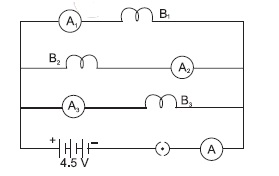
22. What is the role of fuse, used in series with any
electrical appliance? Why should a fuse with defined rating not be replaced by
one with a larger rating?
23. Draw a schematic labeled diagram of a domestic
wiring circuit which includes:
(i) A main fuse (ii) a power meter (iii) one
light point (iv) a power plug
24. Three 2 Ω resistors, A, B and C are connected as
shown in figure. Each of them dissipates energy and can withstand a maximum
power of 18 W without melting. Find the maximum current that can flow through
the three resistors.

25. A battery of 9 V is connected in series with
resistors of 0.2 Ω, 0.3 Ω, 0.4 Ω, 0.5 Ω and 12 Ω resistors. How much current
would flow through the 12 Ω resistor?
26. A child has drawn the electric circuit to study
Ohm’s law as shown in figure. His teacher told that the circuit diagram needs
correction. Study the circuit diagram and redraw it after making all
corrections.
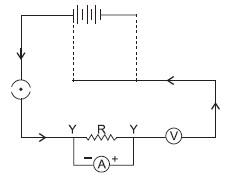
27. A current of 5.0 A flows through a 12 Ω resistor.
What is the rate at which heat energy is produced in the resistor?
28. Calculate the electrical energy consumed by a 1200
W toaster in 20 minutes.
29. Why does the cord of an electric heater not glow
while the heating element does?
30. A lamp rated 100 W at 220 V is connected to the
mains electric supply. (i) What amount of current is drawn from the supply line
if the voltage is 220 V? (ii) What is its resistance?
31. What is an electric circuit? Distinguish between
an open and a closed circuit.
32. What is the (a) highest (b) lowest resistance that
can be secured by combining four coils of resistance 4 Ω, 8 Ω, 12 Ω and 24 Ω.
33. An electric bulb draws a current 0.8 A and works
on 250 V on the average 8 hours a day. If energy costs Rs 3 per kWh, calculate
monthly bill for 30 days.
34. An electric device operates at 24 V and has a
resistance of 8 Ω calculate the power consumed by the device and current
flowing through it.
35. When do you say that the resistance of a wire is 1
Ω?
36. Two identical resistors each of resistance 10 Ω
are connected: (i) in series and (ii) in parallel, to a battery of 6V.
Calculate the ratio of power consumed in the combination of resistors in the
two cases.
37. A TV set shoots out a beam of electrons. The beam
current is 10 mA. How many electrons strike the TV screen per second? How much
charge strikes the screen in a minute?
38. In an electric circuit with a resistance wire and
a cell, the current flowing is I. What would happen to this current if the wire
is replaced by another thicker wire of same material and same length? Give
reason.
39. Two students perform experiments on two given
resistors R1 and R2 and plot the following V-I graphs. If R1 > R2, which of two
diagrams correctly represent the situation on the plotted curves? Justify your
answer.
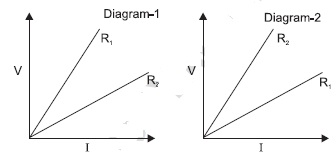
40. In a house, four 60 W electric bulbs are lighted
for 2 hours and two 100 W bulbs are lighted for 4 hours every day. Calculate the
energy consumed in the house for 30 days.
41. A wire of resistance R is cut into three equal
parts.
(i) Find the value of resistance of each part in terms of the
original resistance R?
(ii) If these three pieces are connected in parallel, what is
the ratio of the resistance so obtained to the original resistance?
42. State the law that relates current through a
conductor and the potential difference between its ends. Represent the law
mathematically.
43. In the circuit diagram shown, the two resistance
wires A and B are of same length and same material, but A is thicker than B.
Which ammeter A1 or A2 will indicate higher reading for current? Give reason.
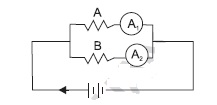
44. State Ohm’s law of electricity and write the
condition in which this law is obeyed.
45. On what factors does the resistance of a conductor
depend? Write SI unit of resistance.
46. Why do we use parallel circuit arrangement for
domestic wiring?
47. Which gas is filled in the electric bulb and why?
48. A wire is cut into three equal parts and then
connected in parallel. How will it:
(a) Resistance
(b) resistivity gets affected?
49. How many electrons will flow for the charge of 4C?
(Charge on 1 electron = 1.6 × 10–19 C)
50. Calculate the resistance of a conductor when the
current flowing through it is 0.2 A and the potential difference is 0.8 V?
51. When a 12 V battery is connected across an unknown
resistor, 2.5 mA current flows in the circuit. Find the resistance of the
resistor.
52. When a 22 V battery is connected across a
resistor, 2.2 mA current flows in the circuit. Find the resistance of the
resistor.
53. Four resistors of 5 Ω, 10 Ω, 15 Ω and 20 Ω are
connected in parallel. Calculate equivalent resistance.
54. An electric heater is used on 220 V supply and
takes a current of 3.4 A. Calculate:
(i) its power; and (ii) its
resistance, when it is in use.
55. One lamp is rated 40 W at 220 V and the other 60 W
at 220 V. These two lamps are connected in parallel to a 220 V supply. Calculate
the current drawn from the supply line by each lamp.
56. An electric iron draws a current of 0.5 A, when
the voltage is 200 V. Calculate the amount of electric charge flowing through
it, in one hour.
57. An electric iron has a rating of 750 W, 220 V.
Calculate
(i) Current passing through it, and
(ii) its resistance, when in use.
58. An immersion heater has a rating of 2 kW, 220 V.
While in use, calculate
(i) Current passing through it
and (ii) its resistance.
59. A 40 watt lamp required 0.20 A of current at 220
volts when in use. Calculate:
(i) its power;
(ii) Its resistance.
SHORT ANSWER QUESTIONS
IMPORTANT QUESTIONS
1. A piece of wire having a resistance R is cut into
six equal parts.
(a) How will the resistance of each part compare with
the original resistance?
(b) If the six parts are placed in parallel, how will
joint resistance compare with the resistance of the original wire?
2. The overall resistance of the circuit diagram below
is 0.5 Ω. Calculate the value of resistance r3.
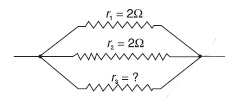
3. In the given circuit diagram, calculate:
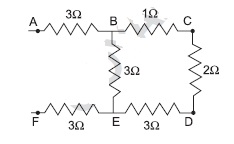
(i)
Total resistance between the points B and E.
(ii)
Total resistance between the points A and F.
4. Answer the following questions about electric bulb:
(i) Why is its filament coiled?
(ii) Why is it filled with argon gas at low
pressure?
(iii) State one disadvantage of filling it with
argon.
5. (a) An electric bulb gives bright light when
connected to 12 V-D.C. sources. Will it glow, if connected to 12 V-A.C. sources?
(b) Two bulbs of 100 W and 25 W are connected in series to 200 V-A.C.
mains. Which bulb glows brightly? Explain the observation.
6. (a) Wires used as leads of an electric oven are
thicker than those used in the leads of table lamp. Explain.
(b) The heating element of a room heater becomes red hot, but
the lamp wires remain cold. Why?
7. A heater coil connected to 200 V has a resistance
of 80 W. If the heater is plugged in for the time ‘t’, such that 1 kg of
water at 20°C attains a temperature of 60° C, then calculate
(a) Power of heater, (b) Heat
absorbed by water, (c) The value of‘t’ in seconds.
8. A 40 W lamp requires 0.182 A current at 220 V while
a 60 W lamp requires 0.272 A current at same volts. If 40 W and 60 W lamps are
connected in series with 220 V line, how many ampere of current will flow
through each lamp?
9. Name an instrument used for measuring electric
potential difference by drawing diagram showing how this instrument is connected
in an electric circuit. Why does not this instrument practically consume any
electric energy from the electric circuit?
10. (i) Name an instrument used for measuring the
electric current.
(ii) How this instrument is connected in an
electric circuit? Support your answer by a diagram.
(iii) Why does not this instrument practically
consume any electric energy from the electric circuit.
11. (a) How does the resistance of the following
change with the rise in temperature?
(i) Pure metals, (ii)
German silver; (iii) carbon
(b) Name three substances whose resistance
changes very little with the rise in temperature?
12. (a) Why are conductors of electric heating
devices, such as toasters and electric iron made of an alloy, rather than pure
metals?
(b) Why is an ammeter likely to burn, if
connected in parallel?
13. A piece of wire is redrawn by pulling it, until
its length is trebled. Compare the new resistance of wire with the original
resistance.
QUESTIONS FROM CBSE EXAMINATION PAPERS
1. For the circuit shown in the diagram given:
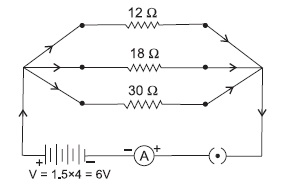
Calculate:
(i)
the total effective resistance of the circuit,
(ii)
the total current drawn from the battery and
(iii)
the value of current through each resistor.
2. Define electric current and state its SI unit. With
the help of Ohm’s law explain the meaning of 1 Ohm resistance.
3. The rating of an electric heater is 1100 W; 220 V.
Calculate its resistance when it operates at 220 V. Also calculate the energy
consumed in kWh in the month of November if the heater is used daily for four
hours at the rated voltage.
4. An air conditioner of rating 2000 W; 220 V is
operated in a domestic circuit (220 V) that has a current rating of 5A. What
result do you expect? Justify your answer.
5. Explain reason for the following:
(i) Tungsten is used almost exclusively for
filament of electric lamps.
(ii) The series arrangement is not used for
domestic circuits.
(iii) Copper and aluminium wires are usually
employed for electricity transmission.
6. The rating of an electric oven is 4400 W; 220 V.
Calculate its resistance when it operates at 220 V. Also calculate the energy
consumed in kWh in the month of September if the oven is used daily for 5 hours
at the rated voltage.
7. A piece of wire of resistance 20 Ω is drawn out so
that its length is increased to twice its original length. Calculate the
resistance of the wire in the new situation.
8. (a) What is the total resistance of n
resistors each of resistance ‘R’ connected in: (i) series (ii) parallel?
(b) Calculate the resultant resistance of 3 resistors
3Ω, 4Ω and 12Ω connected in parallel.
9. (a) For the circuit shown below in the diagram,
calculate:
(i) value of current through the 30Ω resistor.
(ii) total resistance of the circuit.
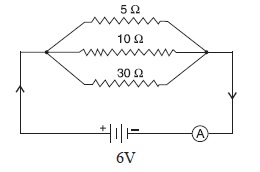
(b) Give two advantages of connecting electrical
devices in parallel with battery.
10. (a) Electric fuse is an important component of all
domestic circuits. Why?
(b) An electric oven of rating 2 kW, 220 V is
operated in a domestic circuit with a current rating of 5 A. What result would
you expect? Explain.
11. (i) State Ohm’s law. Write a mathematical
expression for it.
(ii) What kind of graph is obtained by plotting
values of ‘V’ and ‘I’ why?
12. A lamp rated 40 W and an electric iron rated 800 W
are used for 6 hours every day. Calculate the total energy consumed in 30 days.
13. (a) Explain the function of electric fuse.
(b) An electric bulb is marked 60 W. What
does this mean? How much energy does it consume if used for 1 hour?
14. What would be the reading of ammeter and voltmeter
in the given circuit?
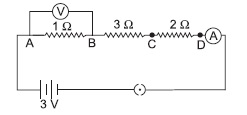
15. Two conducting wires of same material, equal
length and equal diameter are first connected in series. How does the heat
produced by the combination of resistance change?
16. What would be the reading of ammeter and voltmeter
in the given circuit?
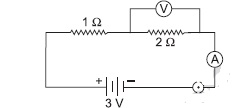
17. Table gives the resistivity of three samples

Which of them is a good conductor and which is an insulator? Why?
(b) A resistance wire (4Ù resistance) is doubled on it,
calculate the new resistance of the wire.
18. Name two safety measures commonly used in electric
circuits and appliances. What precautions should be taken to avoid the over
loading of domestic electric circuits?
19. State Ohm’s law. How can it be verified
experimentally? Does it hold well under all conditions? Comment.
20. (a) How much current will an electric bulb draw
from a 220 V source if the bulb filament has a resistance of 1200 Ω.
(b) How much current will an electric heater draw from a 220 V source if
the resistance of the heater is 100 Ω?
21. What is electrical resistivity? In a series
electrical circuit comprising a resistor made up of a metallic wire, the ammeter
reads 5 A. The reading of the ammeter decreases to half when the length of the
wire is doubled. Why?
22. What is the role of fuse, used in series with any
electrical appliance? Why should a fuse with defined rating not be replaced by
one with a larger rating?
23. Find out the following in the electric circuit
given in figure.

(a) Potential difference across 4Ω resistance
(b) Power dissipated in 4Ω resistor
(c) Difference in ammeter readings, if any
24. (i) What precautions should be taken to avoid the
overloading of domestic electric circuits?
(ii) An electric oven of 2 kW power rating is
operated in a domestic electric circuit. (220V), which has a current rating 5A.
What result do you expect? Explain.
25.
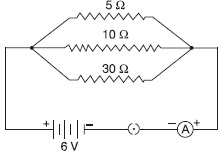
In the above circuit diagram calculate:
(a) the value of current through each resistor,
(b) the total current in the circuit and
(c) the total effective resistance of the circuit.
26. Study the following circuit and answer the
questions:
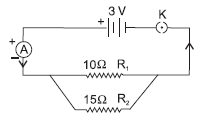
(i) State the type of combination of the two resistors in the
circuit.
(ii) How much current is flowing through?
(a) 10 Ω and
(b) 15 Ω resistors?
(iii) What is the ammeter reading?
27. (a) What is meant by electric resistance of
conductor?
(b) A wire of length L and resistance R is
stretched so that the length is doubled and area of cross section is halved. How
will (i) resistance change and (ii) resistivity change?
28. Express Joule’s law of heating mathematically.
What is the resistance of 12 m wire having radius 2 × 10–4 m, specific
resistivity is 3.14 × 10–8 Ω m.
29. Draw a schematic diagram of a circuit consisting
of 24 V battery, a 10 ohm resistor, a 5 ohm resistor, a 1 ohm resistor, an
ammeter and a plug key, all connected in series. Calculate the ammeter reading
in this circuit.
30. (a) Why are electric toaster and electric iron
made of an alloy rather than pure metal?
(b) An electric iron of resistance 20 Ω
takes a current of 5 A, calculate the heat developed in 30 second.
31. (a) Why is an ammeter likely to burn out if you
connect it in parallel?
(b) Why is series arrangement not found
satisfactory for domestic lights?
32. A copper wire has a diameter of 0.5 mm and a
resistivity of 1.6 × 10–6 ohm-cm. How much of this wire would be necessary to
make a resistance of 10 ohm?
33. A copper wire of length 3m and the area of cross
section 1.7 × 10–6 m2 has a resistance of 3×10–2 ohm. Calculate the resistivity
of copper.
34. An electric lamp of 24 W, and a conductor of 6 W
are connected in series to a 12 V battery. Calculate the:
(i) Total resistance
(ii) total current in the circuit
(iii) potential difference across the
conductor.
35. In a household electric circuit, different
appliances are connected in parallel to one another. Give two advantages of such
connection. Two bulbs rated 100 W, 200 V and 25 W, 200 V are
connected in parallel to a 200 V supply. What will be the current drawn
from the supply line?
36. A student performs an experiment with 4 cells and
a resistance wire and an ammeter in series and observes that when the number of
cells in the circuit is decreased, the value of current through the wire also
decreases. Name the law that is involved in the experiment and write its
mathematical form. V-I graph for two resistors R1, R2 and their series
combination is as below. Which graph represents the series combination of the
other two? Give reason.
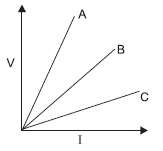
37. For the circuit shown in the diagram calculate:
(a) The total effective resistance of the circuit. (b) The total
current in the circuit. (c) The value of current through 20Ω
resistor.
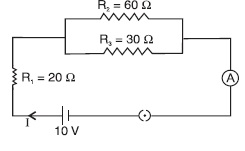
38. Two identical resistors, each of resistance 50Ω
are connected (i) in series (ii) in parallel, in turn, to a battery of 10 V.
Calculate the ratio of power consumed in the combination for resistors in the
two cases.
39. Two resistors of resistances 3Ù and 6Ù
respectively are connected to a battery of 6V so as to have :
(a) Maximum resistance (b) Maximum current
(i) How will you connect the resistances in
each case?
(ii) Calculate the strength of the current in the
circuit in both cases.
40. Two identical resistors, each of resistance 20Ω
are connected (i) in parallel (ii) in series, in turn, to a battery of 10 V.
Calculate the ratio of power consumed in the combination of resistors in the
two cases.
41. A 400 W refrigerator operates for 16 hrs/day;
calculate the cost to operate it for 30 days at Rs. 3.40 per kWh.
42. Calculate the effective resistance between P and
Q.
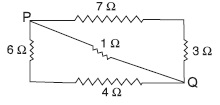
43. A 500W electric iron used in a house for 2 hours
per day. Calculate the cost to use it for 60 days at Rs. 3.20 per kWh.
44. Calculate the effective resistance between P and
Q.

45. An electric heater connected to a 220 V line has
two resistance coil of 22 ohms each. Calculate the current if these coils are
used
(a) Separately (b) In series (c) In Parallel
46. Calculate the Equivalent Resistance from the
following combination of resistors.
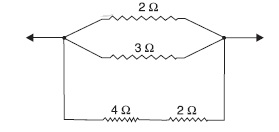
47. Explain the following:
(a) Why is Tungsten used for the filament in electric bulbs?
(b) Why are the conductors of electric heating devices, made
of an alloy?
(c) How does the resistance of a wire vary with its cross
sectional area?
48. How many resistors of 88Ù are connected in
parallel to carry 10 A current on 220 V line?
49. An electric iron consumes energy at a rate of 840
W when heating is at the maximum rate and 360 W when the heating is at the
minimum. The voltage is 220 V. What are the current and the resistance in each
case?
50. In figure ‘A’ R1 = 10Ω, R2 = 40Ω, R3 = 30Ω, R4 =
20Ω, R5 = 60Ω and a 12 V battery are connected to the arrangement. Calculate:
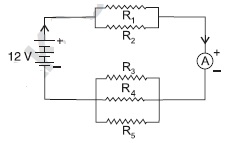
(a) total resistance in the circuit and
(b) total current flowing in the circuit.
51. In figure ‘B’ R1 = 10Ω, R2 = 20Ω, R3 = 25Ω, R4 =
5Ω and a 12V battery is connected to the arrangement. Calculate:
(a) Total resistance in the circuit.
(b) Total current flowing in the circuit.
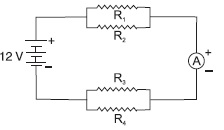
52. (a) State Ohm’s Law.
(b) Draw a schematic diagram of the circuit for studying Ohm’s Law.
53. State the formula correlating the electric current
flowing in a conductor and the voltage applied across it. Also show this
relationship by drawing a diagram. What would be resistance of a conductor if
the current flowing through it is 0.35 ampere when the potential difference
across it is 1.4 volts?
LONG ANSWER QUESTIONS
IMPORTANT QUESTIONS
1. Derive an expression for equivalent resistance (R),
when resistors R1, R2, R3 are connected in series.
2. (i) What do you understand by the term fuse in an
electric circuit?
(ii) State two properties of a material, which make it
suitable for making fuse wire.
(iii) Why is fuse wire always placed in the live wire
of an electric circuit?
(iv) How does fuse wire protect an electric circuit?
(v) Two fuse wires A and B of the same length are rated
15 A and 5A. Which amongst the A and B will be thicker and why?
3. What is electrical resistivity of a material? What
is its unit? Describe an experiment to study the factor is on which the
resistance of conducting wire depends. [HOTS]
4. How will you infer with the help of an experiment
that same current flows through every part of the circuit containing three
resistances in series connected to a battery?
5. How will you conclude that the same potential
difference (voltage) exists across three resistors connected in a parallel
arrangement to a battery?
QUESTIONS FROM CBSE EXAMINATION PAPERS
1. (a) State Ohm’s law. Express it mathematically.
(b) Write symbols used in electric circuits to
represent:
(i) Variable resistance (ii) Voltmeter
(c) An electric bulb is rated 220 V and 100 W. When it
is operated on 110 V, what will be the power consumed?
2. (a) Why is the series arrangement not used for
domestic circuits?
(b) Why is tungsten used almost exclusively for
filament of electric lamps?
(c) Why are the conductors of electric heating devices
such as bread toasters and electric irons made of an alloy rather than a pure
metal?
(d) Why are copper and aluminium wires usually employed for
electricity transmission?
(e) Why does the cord of an electric heater not glow while
the heating element does?
3. (a) Resistors are given as R1 = 10 Ω, R2 = 20 Ω
and R3 = 30 Ω. Calculate the effective resistance when they are connected in
series. Also calculate the current flowing when the combination is connected
to a 6V battery.
(b) 3 resistors R1, R2 and R3 are connected in series to a battery
V. Draw the circuit diagram showing the arrangement. Derive an expression for
the equivalent resistance of the combination.
4. (a) State Ohm’s law.
(b) Draw a circuit diagram for the verification of Ohm’s law.
Also plot graphically the variation of current with potential difference.
(c) Calculate the resistance of a wire, when a potential
difference of 2V is maintained for 1A current to flow through it.
5. Find out the following in the electric circuit
given in figure.
(a) Effective resistance of two 8 Ω resistors in the
combination
(b) Current flowing through 4 Ω resistor
(c) Potential difference across 4 Ω resistor
(d) Power dissipated in 4 Ω resistor
(e) Difference in ammeter readings, if any.
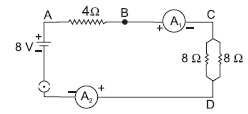
6. A current of 1 ampere flows in a series circuit
containing an electric lamp and a conductor of 5 Ω when connected to a 10 V
battery. Calculate the resistance of the electric lamp. Now if a resistance of
10 Ω is connected in parallel with this series combination, what change (if
any) in current flowing through 5 Ù conductor and potential difference across
the lamp will take place? Give reason. Draw circuit diagram.
7. (a) Which effect of the electric current is
utilized in the working of an electrical fuse?
(b) A fuse is connected in series or in parallel in
household circuit?
(c) Draw a schematic labeled diagram of a domestic
circuit which has a provision of a main fuse, meter, one light bulb and a
switch/socket.
8. (a) What is the function of earth wire in
electrical instruments? Why is it necessary to earth the metallic electric
appliances?
(b) Explain what is short circuiting and overloading in an
electric supply?
9. (a) Derive an expression for the equivalent
resistance of three resistors R1, R2 and R3 connected in parallel.
(b) Fuses of 3A, 5A and 10A are available. Calculate
and select the fuse for operating electric iron of 1 kW power at 220 V line.
10. (a) Define one ohm.
(b) How many 330Ω resistors in parallel are
required to carry 20 A on 220 V line?
(c) Name a component used to regulate
current without changing the voltage source.
(d) A 10Ω resistance wire is doubled on it
calculate the new resistance of wire.
11. (a) Draw a schematic diagram of the common
domestic circuit.
(b) Write difference between overloading
and short circuiting.
12. Answer the following questions:
(i) Why do we connect earth wire in a house? Give
two reasons.
(ii) What type of current is used in household
supply?
(iv)
What type of current is given by a cell?
(iv) To which wire do you connect fuse-wire in a household circuit?
13. A current of 1 ampere flows in a series circuit
containing an electric lamp and a conductor of 5 Ω when connected to a 10 V
battery. Calculate the resistance of the electric lamp. Now if a
resistance of 10 Ω is connected in parallel with this series combination,
what change (if any) in current flowing through 5 Ω conductor and potential
difference across the lamp will take place? Give reason. Draw circuit diagram.
14. (a) Define the term ‘volt’.
(b) State the relationship between work, charge
and potential difference for an electric circuit. Calculate the potential
difference between two terminals of a battery, if 100 joules of work is required
to transfer 20 coulombs of charge from one terminal of battery to the other.
15. (a) What do the following symbols mean in the
circuit diagrams?

(b) An electric circuit consisting of 0.5 m long nichrome
wire XY, an ammeter, a voltmeter, four cells of 1.5 V each and plug key were
set-up.
(i) Draw the diagram of this electric circuit to study
the relation between potential differences maintained between the points X and Y
and electric current flowing through XY.

(ii) The graph shown is plotted between V and I values.
What would be the value of ratio, when potential difference is 0.8 V 1.2 V
and 1.6 V. What conclusion you draw from these values?